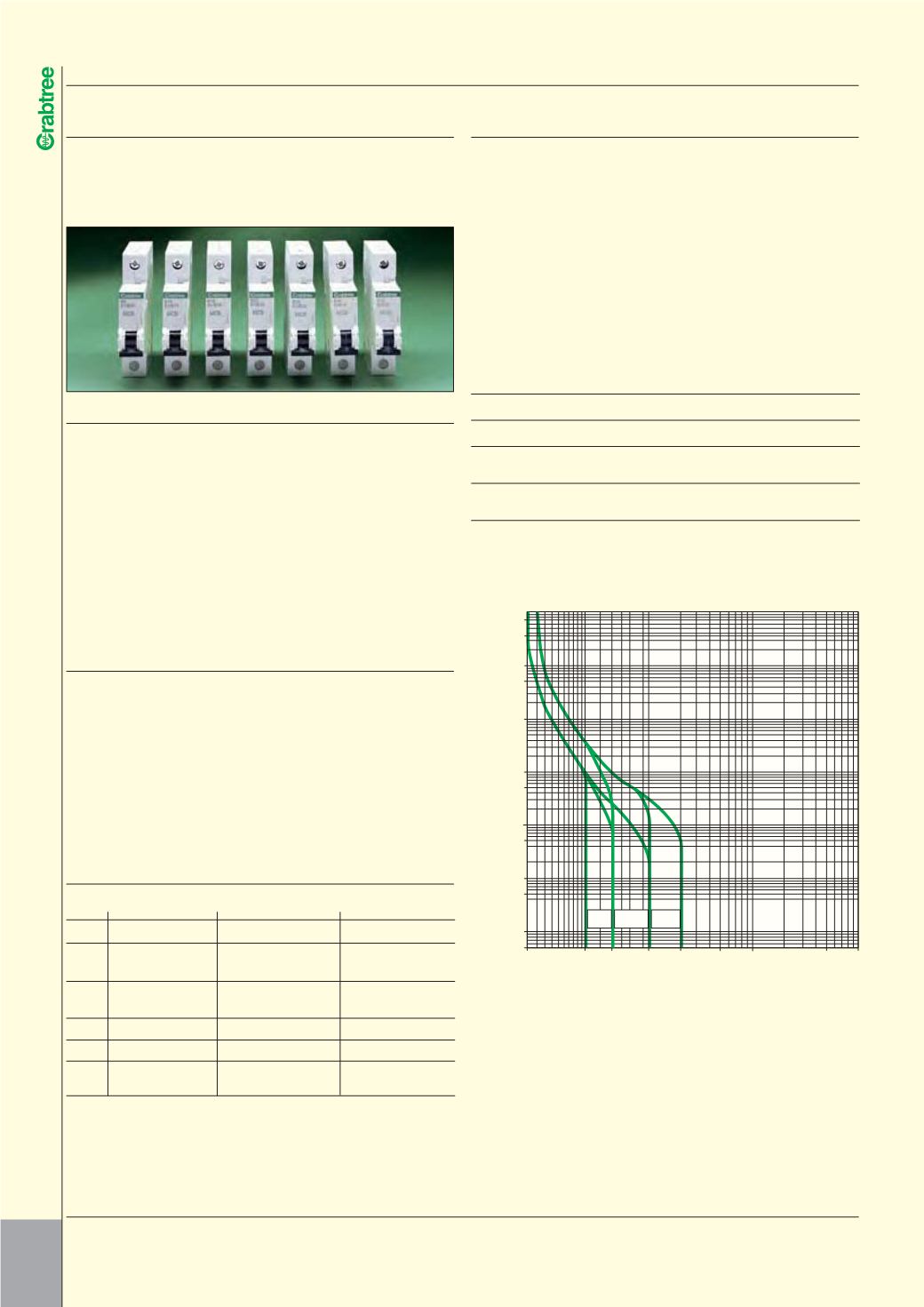

178
TECHN I CAL DATA
C I RCU I T P ROT ECT I ON
TYPE CLASSIFICATION
l
BS EN 60898 specifies different tripping characteristics for different types of
MCB, depending on the level of overload current required to make the MCB
trip out in less than 100 milliseconds. Crabtree MCBs within this publication
are available as types B and C, enabling installation designers to choose an
MCB with a characteristic closely matched to the circuit requirement.
FAULT LEVELS
l
Regulation 432.1 of BS 7671 requires that a device providing protection
against overload currents and fault currents shall be capable of breaking any
overcurrent up to and including the prospective fault current at the point
where the device is installed.
In domestic situations this could be as high as 16kA, in industrial situations it
could be even higher.
According to regulation 434.5.1, the prospective fault current can be higher
than the breaking capacity of the protective device if another protective
device having the necessary breaking capacity is installed on the supply side.
This means that MCBs can be backed up by devices of greater capacity such
as HRC fuses.
When providing back-up protection, consideration must be given to
discrimination. Discrimination is said to occur when the device nearest the
fault operates first.
AMBIENT TEMPERATURE CONSIDERATIONS
l
Starbreaker and Loadstar MCBs are calibrated to meet the requirements of
BS EN 60898, 30°C Reference Calibration Temperature. At other temperatures
the following rating factors should be used:
At 40°C 0.9
At 20°C 1.0
At 0°C 1.1
Adjacent thermal-magnetic MCBs should not be continuously loaded at or
approaching their nominal rated currents when mounted in enclosures. It is
good engineering practice to apply generous de-rating factors or make
provision for adequate free air between devices. In these situations, and in
common with other manufacturers, we recommend a 70% diversity factor is
applied to the MCB nominal rated current where it is intended to load the
MCBs continuously (in excess of 1 hour).
OPERATING CHARACTERISTICS FOR MCBs
l
MCB
BS EN 60898
Instantaneous trip
type
type
current range
Typical application
B
B
3–5
I
n
Domestic
C
C
5–10
I
n
Commercial
Light Industrial
D
D
10–20
I
n
General
Industrial
1*
–
2.7–4
I
n
Domestic
2*
–
4–7
I
n
Commercial
3*
–
7–10
I
n
General
Industrial
* MCBs, type 1,2 & 3 to BS 3871
MINIATURE CIRCUIT BREAKERS
l
Crabtree MCBs comply fully with BS EN 60898 and therefore enable the requirements of BS 7671 to be met.
FAULT PROTECTION
l
BS 7671, formerly the IEE Wiring Regulations requires that measures are
taken to protect against the risk of electric shock, which can be the result of
contact with live parts.
MCBs can be used in conjunction with earthed equipotential bonding to
achieve disconnection times of 0.4 seconds (411.3.2.2) for final circuits not
exceeding 32A and 5 seconds (411.3.2.3) for final circuits exceeding 32A
(TN Systems).
EARTH FAULT LOOP IMPEDANCES (Z
S
OHMS) TO GIVE COMPLIANCE
WITH BS 7671 REGULATION 411.3.2.2 AND 411.3.2.3 AT 230V
Maximum earth fault loop impedance in ohms for instantaneous operation of
devices giving compliance with the 0.4 second disconnection time of
Regulation 411.3.2.2 and 5 second disconnection time of Regulation
411.3.2.3.
RATINGS
DEVICE BS EN 6A 10A 16A 20A 32A 40A 50A
MCB
60898 7.666 4.599 2.874 2.299 1.439 1.149 0.919
Type B
MCB
60898 3.829 2.299 1.439 1.149 0.719 0.569 0.459
Type C
RCBO
61009 1667 1667 1667 1667 1667 1667 1667
30mA
Type B
RCBO
61009 1667 1667 1667 1667 1667 1667 1667
30m
Type C
The values in these tables should be modified to allow for the cable temperature at
time of test
RCBO values reflect the rated residual operating current characteristics of the device
(table 41.5). For the overcurrent characteristics read as related MCB values.
RMS PROSPECTIVE CURRENT AS A MULTIPLE OF RATED CURRENT
OPERATING TIME IN SECONDS
2 HRS
1 HR
1,000
100
10
1.0
0.1
0.01
0.001
1
3 5 10 20
100
1,000
Type
B
Type
C
Type
D



















